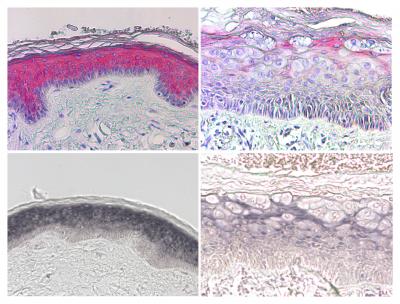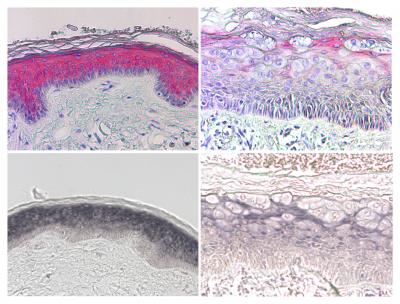
Credit: Marthaler AM, et al. (2017)
Scientists have identified a molecular pathway by which some types of human papilloma virus (HPV) might increase the risk of skin cancer, particularly in people with the rare genetic disorder epidermodysplasia verruciformis (EV). The novel pathway is described in PLOS Pathogens.
Some HPV types of the genus known as beta-HPV infect skin cells and can increase the risk of non-melanoma skin cancer, especially in people with weakened immune systems or EV. Previous research has suggested that a type of HPV protein called E6 underlies this increased cancer risk, but the molecular mechanisms by which E6 proteins may act are unclear.
To better understand the role of E6 proteins in skin cancer, a team led by Sigrun Smola, professor and chair of the Institute of Virology, Saarland University, Germany, focused on HPV infection in EV patients. EV makes people particularly vulnerable to infection with beta-HPV strains, so the disease provides a useful opportunity to study beta-HPV infection mechanisms.
The research team obtained samples of skin lesions from EV patients; some of these lesions tested positive for infection with HPV8, a type of beta-HPV. Molecular analysis revealed that the HPV8-infected lesions expressed significantly lower levels of microRNA-203, a known regulator of skin cell growth and differentiation. The HPV8-infected lesions also had higher levels of p63, a protein that is regulated by microRNA-203 and has been associated with cancer development.
Lab experiments with human skin cells performed predominantly by Anna Marthaler, PhD, then revealed molecular links between these microRNA-203/p63 effects and HPV8 infection. The results suggested that HPV8's E6 protein suppresses expression of C/EBPα, a protein that is known to play a key role in curbing the development of sun-induced skin cancer.
Additional analysis showed that C/EBPα directly regulates microRNA-203 and is in turn regulated by the protein p300, a known target of E6 proteins. The researchers also showed that HPV8-infected skin lesions from EV patients had significantly lower levels of C/EBPα and microRNA-203 than did non-lesional skin cells.
Overall, these findings suggest the existence of a previously unknown molecular pathway involving p300, C/EBPα, and microRNA-203 that helps to maintain normal skin cell proliferation and differentiation. HPV8's E6 protein appears to disturb the normal function of this pathway in EV patients, potentially paving the way for skin cancer.
"Our findings are particularly exciting because we now better understand how beta-HPV infection can contribute to UV-induced skin carcinogenesis," the authors explain. "This discovery opens new avenues for therapeutic interventions against skin cancer."
###
In your coverage please use this URL to provide access to the freely available article in PLOS Pathogens: http://journals.plos.org/plospathogens/article?id=10.1371/journal.ppat.1006406
Citation: Marthaler AM, Podgorska M, Feld P, Fingerle A, Knerr-Rupp K, Grässer F, et al. (2017) Identification of C/EBPα as a novel target of the HPV8 E6 protein regulating miR-203 in human keratinocytes. PLoS Pathog 13(6): e1006406. https://doi.org/10.1371/journal.ppat.1006406
Funding: This work was supported by a grant of the Saarland Staatskanzlei to SS (WT/2–LFFP 14/15). The funders had no role in study design, data collection and analysis, decision to publish, or preparation of the manuscript.
Competing Interests: HS is currently employed by Paul Hartmann AG. However, for clarification, no materials or support were received from this company, and no agreements were in place concerning the execution or publication of this work. This does not alter our adherence to all PLoS Pathogens policies on sharing data and materials. The other authors have declared that no competing interests exist.
Media Contact
PLOS Pathogens
[email protected]
Related Journal Article
http://dx.doi.org/10.1371/journal.ppat.1006406
############
Story Source: Materials provided by Scienmag





